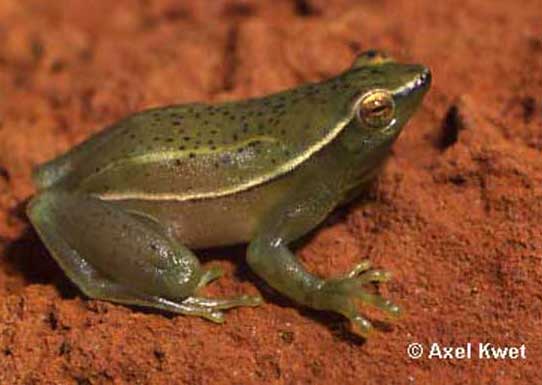
Sphaenorhynchus surdus (*)
Superregnum: Eukaryota
Regnum: Animalia
Subregnum: Eumetazoa
Cladus: Bilateria
Cladus: Nephrozoa
Superphylum: Deuterostomia
Phylum: Chordata
Cladus: Craniata
Subphylum: Vertebrata
Infraphylum: Gnathostomata
Superclassis: Tetrapoda
Classis: Amphibia
Subclassis: Lissamphibia
Ordo: Anura
Familia: Hylidae
Subfamilia: Scinaxinae
Genus: Sphaenorhynchus
Species: Sphaenorhynchus surdus
Name
Sphaenorhynchus surdus (Cochran, 1953)
Type locality: "prairie just south of town [Curitaba]".
Holotype: UMMZ 106736.
Synonyms
Hyla aurantiaca surda Cochran, 1953
Sphoenohyla surda — Goin, 1957
Sphoenorhynchus surdus — Bokermann, 1966
Sphaenorhynchus surdus — Rivero, 1969
References
Cochran, 1953, Herpetologica, 8: 112.
Rivero, 1969, Copeia, 1969: 702.
Frost, D.R. 2021. Amphibian Species of the World: an Online Reference. Version 6.1. Electronic Database accessible at https://amphibiansoftheworld.amnh.org/index.php. American Museum of Natural History, New York, USA. DOI: 10.5531/db.vz.0001 Sphaenorhynchus surdus . Accessed on 18 Apr 2008.
2007 IUCN Red List of Threatened Species IUCN: Sphaenorhynchus surdus (Least Concern) Downloaded on 18 April 2008.
Vernacular names
English: Cochran's Lime Treefrog
Sphaenorhynchus surdus, or Cochran's lime treefrog, is a species of frog in the family Hylidae. It is endemic to southern Brazil and is known from the eastern Paraná, Santa Catarina, and northeastern Rio Grande do Sul states.[1][2] Before Sphaenorhynchus caramaschii was described in 2007, all Sphaenorhynchus from the south of the state of São Paulo state all way south to Rio Grande do Sul were identified as S. surdus.[3]
Description
Adult males measure 23–29 mm (0.91–1.14 in) in snout–vent length. There is a dark dorso-lateral line running from the snout almost to the groin. No externally visible tympanum is present.[3] A late-stage tadpole (Gosner stage 37) measured 53.5 mm (2.11 in) in total length, of which the body made 18.5 mm (0.73 in).[4] Males call from the floating vegetation during the hot, rainy season. The call is short, usually less than 2 seconds in duration. The dominant frequency is 2.2–2.4 kHz.[3]
Habitat and conservation
The species' natural habitats are low bushes surrounding large permanent lakes at elevations of 100–1,200 m (330–3,940 ft) above sea level. Although an abundant species, water pollution is a threat to it.[1]
References
Luis Felipe Toledo (2008). "Sphaenorhynchus surdus". IUCN Red List of Threatened Species. 2008: e.T56022A11411506. doi:10.2305/IUCN.UK.2008.RLTS.T56022A11411506.en. Retrieved 17 November 2021.
Frost, Darrel R. (2017). "Sphaenorhynchus surdus (Cochran, 1953)". Amphibian Species of the World: an Online Reference. Version 6.0. American Museum of Natural History. Retrieved 30 May 2017.
Toledo, Luís Felipe; Garcia, Paulo C. A.; Lingnau, R.; Haddad, Célio F.B. (2007). "A new species of Sphaenorhynchus (Anura; Hylidae) from Brazil". Zootaxa. 1658: 57–68. doi:10.11646/zootaxa.1658.1.4.
Caramaschi, U. (2010). "Descrição do girino de Sphaenorhynchus surdus (Cochran, 1953) (Anura, Hylidae)" [Description of the tadpole of Sphaenorhynchus surdus (Cochran, 1953) (Anura, Hylidae)] (PDF). Boletim do Museu de Biologia Mello Leitão. Nova Série. 27: 67–74.
Retrieved from "http://en.wikipedia.org/"
All text is available under the terms of the GNU Free Documentation License

